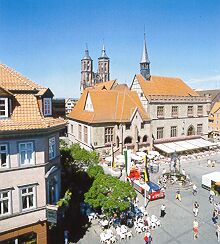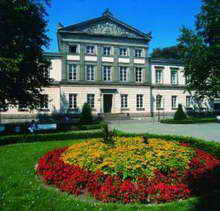

| The
City
Göttingen is situated in the centre of Germany, with the Harz Mountains on its north-eastern side and the Weser River and Weser Bergland towards the west. The town, which dates from the twelth century, at present has some 130.000 inhabitants. Its old centre is characterized by an ensemble of attractive half-timbered dwellings, in part dating from the late Middle Ages. In building and restoring the old City Hall, the medieval churches as well as many other structures, extensive use has been made of Permo-Triassic New Red Sandstone, giving the architecture a warm reddish-brown hue. Göttingen offers a varied programme of cultural activities, which includes the Deutsches Theater and – in springtime – the Händel Festival. The numerous parks and adjacent forested areas provide ample opportunity for walks and bicycle rides. Information for tourists (in English) |
 |
|
|
Market place and Johanniskirche
|
||
 Historical festival hall of Göttingen university (1837)
|
The University
Founded in 1737 by Georg August, the Prince Elector of Hanover who as George II also occupied the British throne, the Georgia Augusta rapidly acquired an international reputation. With a particularly great tradition in the natural sciences, its cumulative contribution to academic learning since its founding is second to none. Ever since Nobel Prizes were first awarded in 1901, Göttingen has been associated with a disproportionately large number of these and is the record-holder on the European Continent. The University's academic culture has been enriched by the founding of the Göttingen Academy of Sciences in 1751, and, following World War II, the establishment of several Max Planck Institutes, among them the MPI for History. (English Homepage of Göttingen university) |

